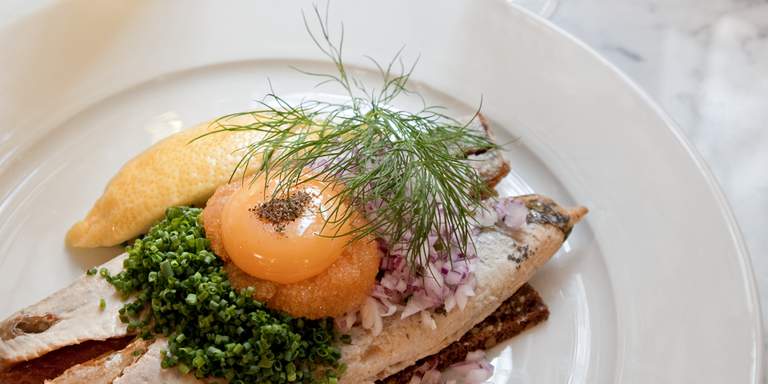Traditional Swedish food in Stockholm
Publish date: 22 August 2024
Want to sample the classics of Swedish cuisine? Here's where!
Stockholm's restaurant scene is a melting pot of flavors from around the world. But of course, you'll find great examples of typical Swedish cuisine, often in contemporary interpretations.
Regional differences aside, traditional Swedish cuisine relies heavily on dairy products, root vegetables, seafood, different kinds of meat, berries, and eggs. Nowadays, you'll find pasta and rice in almost any household.
For a long time though root vegetables, especially potatoes, were the go-to source of carbohydrates. As the Swedish climate doesn't naturally lend itself to growing citrus fruits, vinegar has also been used instead in cooking and preserving food.
Some typical Swedish dishes
- Pickled herring – A mainstay on Swedish holiday buffets, for example on Christmas, Easter, and Midsummer's Eve. Usually eaten accompanied by boiled potatoes or rye bread. The Swedish variant has a sweeter taste than for example the Polish or Ukrainian equivalent, which tends to be saltier. A relative of the pickled herring is the infamous fermented herring.
- Kroppkakor – Boiled potato dumplings filled with a mixture of onions and pork (there are vegetarian and vegan variants as well), spiced with allspice. Served with lingonberry jam and clarified butter. There are various regional differences. Kroppkakor from Öland have raw potatoes in the dough, while the variant from Småland usually uses boiled potatoes. Pitepalt, a similar dish from Northern Sweden, has dumplings made entirely of raw, shredded potato.
- Renskav – Sautéed reindeer in a creamy sauce, served with potatoes (boiled or mashed) and lingonberry jam. Renskav is a traditional Sámi-dish from northern Sweden, with variants found all over the Sápmi region.
- Swedish Meatballs – While not a Swedish invention by any means, meatballs have become the poster child of the Swedish kitchen. The typical way to serve them is with mashed potatoes, creamy gravy, lingonberry jam, and pickled cucumber (psst! Check out our meatball guide for more info on this national icon).
- Raggmunk – The Swedish version of a potato pancake is called raggmunk, and resembles the Swiss rösti pancake. Raggmunk is usually served with pork and, you guessed it, lingonberry jam. While a raggmunk is made by adding shredded potato to pancake batter, there are several similar dishes. Råraka, for example, is made of nothing but shredded potato (ie. no batter) while potatisbullar are patties of mashed potato and egg, turned in breadcrumbs.
- Pyttipanna – Pyttipanna, or simply just pytt, was originally leftover food. Small pieces of whatever vegetables and meat you had, served with a fried egg and pickled beetroot. You'll find variants of the dish all over the Nordic region. Another Swedish take on it, for example, is Biff Rydberg which is a more fancy pytt made of larger pieces of prime meat cuts (usually beef tenderloin).
- Yellow pea soup (ärtsoppa) and pancakes – Pea soup has been a staple of the Swedish menu for hundreds of years. Legend has it that the Swedish King Erik XIV was poisoned after eating a mixture of pea soup and arsenic. As in Finland and Denmark, pea soup is usually followed by pancakes (with jam and/or whipped cream). Not as desert, mind you, but in a way as two halves of the same dish; one savory and one sweet. Pea soup is traditionally eaten on Thursdays.
